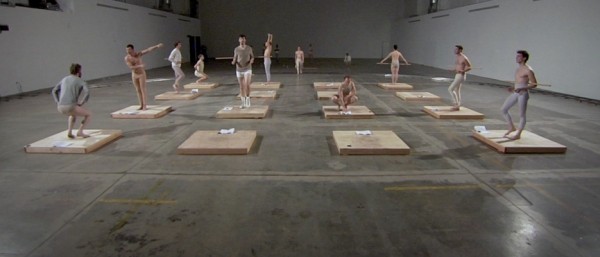JESSE ARON GREEN: ÄRZTLICHE ZIMMERGYMNASTIK AN INSTALLATION OF A VIDEO, A BOOK, IMAGES, SCULPTURES AND A READING PERFORMANCE.

Jesse Aron Green: Ärztliche Zimmergymnastik, HD-video still, 2008 © the artist
Published in 1855, Schreber's book is an early indicator of Western Modernity. It seems to prepare the mind and body for the later industrialization of both labour and leisure through corporal restraint and punishment. Schreber's conception of public health also included his thoughts about "healthy libido release," which he thought must be regulated to accord to societal norms. This classification of human subjectivity and sexuality resulted in categories like "normal" and "abnormal," which entail an ideological imperative. Informed by Minimalism, Structuralism in film, and Conceptual Art, Jesse Aron Green's work negotiates these categories by way of references to seminal and contrasting bodies of thought in Western Modernity, which blossomed in the early parts of the 20th century: reform movements based in physical culture, and psychoanalysis, both of which are denoted in Ärztliche Zimmergymnastik in association with classifications of sexuality and societal disasters, such as war and Colonialism. As the work illustrates, Western standards have long-reaching effects on a global scale, and reveal both the societal conditioning upon individuals, as well as the enlightening power of the concept of the individual.
Built at the end of the 19th Century, the Leipzig Cotton Spinning Mill is a prototypical example of a master-plan in industrial development, invented to improve as well as to regulate and calibrate labour, urban housing and leisure. One can imagine a worker in the production halls of the Spinning Mill following his "system of hygienic exercises" before or after work. Yet Jesse Aron Green's work demonstrates neither subjugation nor resistance to a system. The performers in the large-scale, high-definition video installation break out of the fixed grid on which they enact their exercises, in order to re-enter and leave it again. The conceptual strategies of artists like Sol LeWitt can be seen in the video, as Green has organized the space using quadratic sculptures on the floor that serve as individual stages for each performer. The organization continues in the space of the installation, wherein cubic sculptures serve as seats, and seem to build a relation between the viewer and the performers on screen.
Green considers neither Schreber's book nor Sol LeWitt’s conceptual minimalism from the perspective of a historian. He confronts himself and his viewers with societal norms of the past, which might extend into the present. In particular, the site of the Leipzig Cotton Spinning Mill is a manifestation of societal and ideological structures in the form of industrial-architecture. Although the Spinning Mill does not produce cotton anymore, the installation of Ärztliche Zimmergymnastik at Halle 14 is a reminder of our internalized, continuous alliance with industrialized and cultural norms, and its reverberation into the current state of Capitalism.
Guest-curated by Doreen Mende
September 11 – October 10, 2010
Halle 14 Leipzig Cotton Spinning Mill
September 11, 11AM: Private View
September 11, 4PM: Reading Performance with Jesse Aron Green in the allotment gardens (Schrebergarten) #9 and #10, opposite of the entrance of the Leipzig Cotton Spinning Mill.
September 11, 5PM: Artist's Talk in the visiting centre of Halle 14
Opening during the GalleryTour Leipzig www.SpinnereiGalerien.de
September 11 from 11AM to 9PM and September 12 from 11AM to 6PM
HALLE 14
Leipziger Baumwollspinnerei
Spinnereistr. 7
04179 Leipzig
Tuesday – Sunday 11AM to 6PM
www.halle14.org
